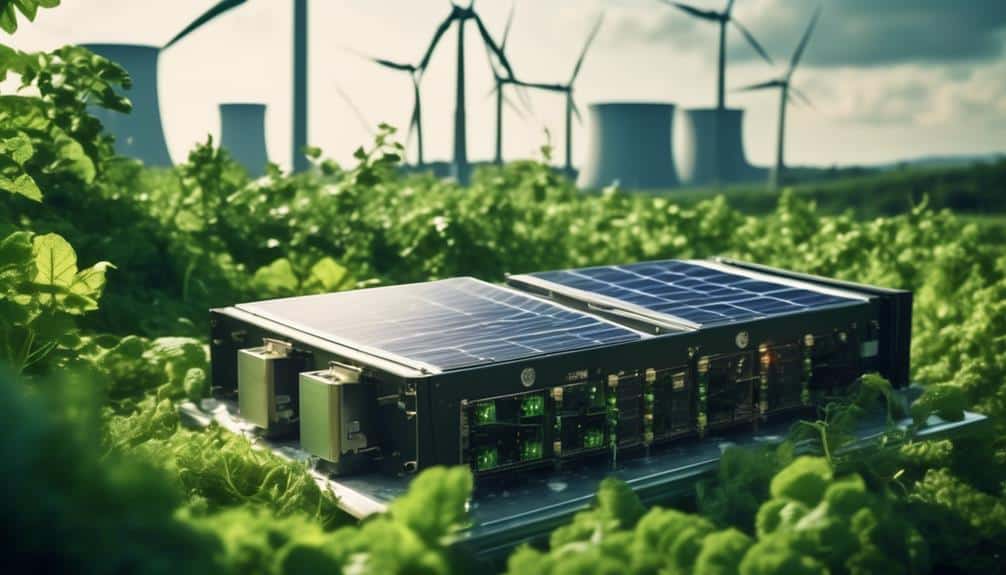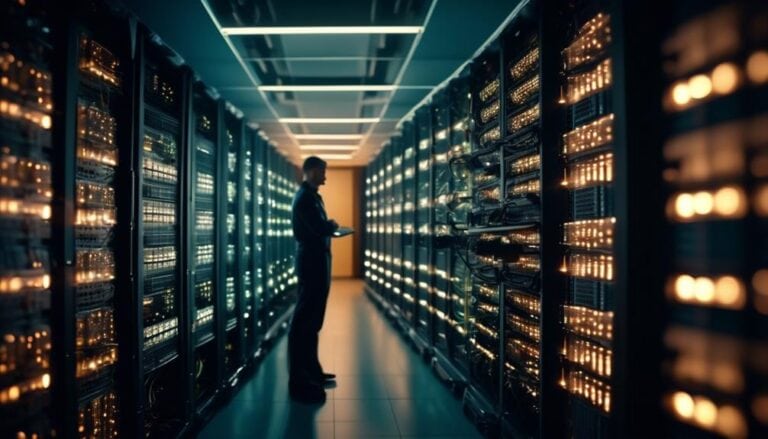Eco-Friendly Hosting Face-Off: Benefits and Limitations You Need to Know
In a world where technology continues to advance at a rapid pace, the need for sustainable practices becomes increasingly important.
Enter the eco-friendly hosting face-off, a clash between the benefits and limitations of environmentally conscious web hosting.
You may think that hosting your website on a green platform is a no-brainer, but there's more to it than meets the eye.
From reducing your carbon footprint to considering the cost implications, this discussion will shed light on the intricacies of eco-friendly hosting and leave you wondering: is it worth the switch?
Key Takeaways
- Green hosting aims to minimize the carbon footprint associated with web hosting by utilizing sustainable technology and practices.
- Traditional hosting relies on energy-intensive data centers and consumes vast amounts of electricity, while green hosting focuses on energy efficiency and reducing carbon emissions.
- Eco-friendly hosting uses renewable energy sources like solar, wind, and hydroelectric power, significantly reducing its carbon footprint.
- Green hosting providers invest in energy-efficient infrastructure, utilize virtualization technologies, and implement effective waste management practices to achieve carbon neutrality.
Green Hosting Explained

Green hosting is a sustainable and environmentally conscious approach to web hosting that aims to minimize the carbon footprint associated with hosting websites. It focuses on utilizing sustainable technology and practices to reduce the environmental impact of hosting servers and data centers.
One key aspect of green hosting is achieving carbon neutrality. This means that the hosting provider takes steps to offset or reduce the carbon emissions produced by their operations. This can be done through various methods, such as investing in renewable energy sources like solar or wind power, or by purchasing carbon credits to offset their emissions.
In addition to carbon neutrality, green hosting also emphasizes the use of sustainable technology. This includes energy-efficient servers and cooling systems, as well as utilizing virtualization techniques to maximize server utilization and reduce resource waste.
Environmental Impact of Traditional Hosting
To understand the environmental impact of traditional hosting, it's important to consider the contrasting practices employed in non-green hosting solutions. Traditional hosting typically relies on energy-intensive data centers that consume vast amounts of electricity to power and cool the servers. These data centers often use outdated infrastructure and equipment, leading to unnecessary energy waste.
In contrast, eco-friendly hosting providers prioritize energy efficiency by using state-of-the-art technologies and practices. Energy-efficient data centers are a key aspect of reducing the environmental impact of traditional hosting. These data centers are designed to minimize energy consumption through various means, such as utilizing advanced cooling systems, optimizing server utilization, and implementing power management techniques.
By reducing the amount of energy required to operate the servers, energy-efficient data centers help to lower carbon emissions and decrease the overall environmental footprint of traditional hosting. Furthermore, environmental certifications play a crucial role in measuring and verifying the sustainability efforts of traditional hosting providers.
Certifications like LEED (Leadership in Energy and Environmental Design) and ISO 14001 assess the environmental performance of data centers by evaluating factors such as energy efficiency, waste management, and carbon emissions. These certifications provide customers with transparency and assurance that the hosting provider is actively working towards reducing its environmental impact.
Benefits of Eco-Friendly Hosting

Eco-friendly hosting offers a variety of benefits for businesses and the environment. One of the key advantages is the use of renewable energy sources. Unlike traditional hosting, which relies heavily on fossil fuels, eco-friendly hosting harnesses the power of renewable energy such as solar, wind, and hydroelectric power. By utilizing these sustainable energy sources, businesses can significantly reduce their carbon footprint.
Reducing carbon footprint is another major benefit of eco-friendly hosting. The carbon footprint refers to the amount of greenhouse gas emissions, particularly carbon dioxide, produced by an individual or an organization. Traditional hosting contributes to a significant amount of carbon emissions due to the energy consumption required to power servers and cooling systems. In contrast, eco-friendly hosting solutions prioritize energy efficiency and the use of renewable energy sources, resulting in a substantial reduction in carbon emissions.
Renewable Energy Sources in Hosting
With a focus on sustainability and reducing carbon emissions, hosting providers have turned to renewable energy sources as a more environmentally friendly alternative to traditional energy consumption. Renewable energy sources, such as solar and wind power, are harnessed to power data centers and other hosting infrastructure. This shift towards renewable energy is driven by the desire to reduce the environmental impact of hosting services.
To further support their commitment to renewable energy, many hosting providers purchase renewable energy credits. These credits represent the environmental benefits of generating renewable energy, and by purchasing them, hosting providers can offset a portion or all of their carbon emissions. This allows them to effectively neutralize their carbon footprint and contribute to the development of renewable energy projects.
In addition to utilizing renewable energy sources, hosting providers are also investing in energy-efficient data centers. These data centers are designed to minimize energy consumption through various means, such as using energy-efficient servers, optimizing cooling systems, and employing advanced power management techniques. By implementing these measures, hosting providers can significantly reduce their energy consumption and further contribute to a more sustainable hosting industry.
Carbon Footprint Reduction Strategies

Hosting providers employ various strategies to reduce their carbon footprint and minimize the environmental impact of their services. By implementing renewable energy alternatives and leveraging sustainable technology advancements, they can significantly decrease their overall carbon emissions.
Here are some key strategies that hosting providers are using:
- Renewable Energy Sources: Hosting providers are increasingly turning to renewable energy sources such as solar, wind, and hydropower to power their data centers. This shift helps reduce reliance on fossil fuels and lowers carbon emissions.
- Energy-Efficient Infrastructure: Hosting providers are investing in energy-efficient infrastructure, including servers, cooling systems, and data center designs. By optimizing energy consumption and reducing waste, they can lower their carbon footprint.
- Virtualization and Consolidation: Hosting providers are using virtualization technologies to consolidate servers and optimize resource utilization. This approach not only improves efficiency but also reduces energy consumption and carbon emissions.
- Waste Management: Hosting providers are implementing effective waste management practices, including recycling and proper disposal of electronic waste. This ensures that harmful materials are handled responsibly, minimizing their impact on the environment.
- Carbon Offsetting: Some hosting providers are going beyond reduction strategies and actively offsetting their carbon emissions by investing in projects that reduce greenhouse gas emissions, such as reforestation or renewable energy initiatives.
Limitations of Eco-Friendly Hosting
When it comes to eco-friendly hosting, there are several limitations that need to be considered.
One of the main challenges is energy consumption, as hosting providers need to ensure their servers are powered by renewable energy sources.
Additionally, there may be limitations in terms of the availability of these resources, especially in certain geographic locations.
Energy Consumption Challenges
One of the challenges faced in eco-friendly hosting is the need to address energy consumption limitations. As the demand for online services continues to grow, data centers consume large amounts of energy, contributing to carbon emissions and environmental degradation.
To overcome this challenge, hosting providers are adopting energy-efficient practices and sustainable technologies. Here are some key considerations:
- Energy-efficient infrastructure: Hosting providers are investing in energy-efficient hardware and infrastructure to minimize energy consumption and optimize performance.
- Renewable energy sources: Many eco-friendly hosting providers are sourcing their energy from renewable sources such as solar or wind power, reducing their carbon footprint.
- Virtualization and consolidation: By using virtualization techniques and consolidating servers, hosting providers can reduce the number of physical servers required, leading to lower energy consumption.
Resource Limitations
To address the resource limitations faced in eco-friendly hosting, it's crucial for hosting providers to implement strategies that maximize efficiency and minimize waste. One key limitation is the availability of renewable resources.
Eco-friendly hosting relies on renewable energy sources such as solar or wind power. However, the availability and reliability of these resources can vary depending on factors like location and weather conditions. Hosting providers need to consider these limitations and explore alternative sources of renewable energy to ensure a consistent and sustainable power supply.
Another limitation is the implementation of sustainable practices. Eco-friendly hosting requires using energy-efficient hardware and adopting sustainable practices throughout the data center operations. This includes optimizing cooling systems, reducing energy consumption through virtualization, and recycling electronic waste.
However, implementing these practices may require significant upfront investments and ongoing maintenance costs. Hosting providers must carefully balance the costs and benefits of sustainable practices to ensure long-term viability and environmental impact.
Despite these limitations, eco-friendly hosting remains an important step towards reducing the carbon footprint of the web hosting industry.
Cost Considerations
While eco-friendly hosting offers numerous environmental benefits, there are certain cost considerations that hosting providers must take into account. Here are some key points to consider:
- Initial Investment:
- Implementing energy-efficient infrastructure requires an upfront investment in eco-friendly technologies, such as high-efficiency servers and renewable energy sources.
- These initial costs may be higher than traditional hosting methods, requiring careful financial planning.
- Operational Expenses:
- Energy-efficient hosting reduces operational expenses in the long run due to lower energy consumption.
- By using energy-saving technologies and renewable energy sources, hosting providers can significantly reduce their electricity bills over time, resulting in long-term savings.
While the initial investment may seem daunting, the long-term savings from energy efficiency can outweigh the upfront costs. It's crucial for hosting providers to carefully evaluate their budget and weigh the benefits of eco-friendly hosting against the potential cost considerations.
Cost Considerations for Green Hosting
When considering green hosting, one of the main points to consider is the price.
Green hosting services may have a slightly higher upfront cost compared to traditional hosting options.
However, it's important to note that there are also economic benefits associated with eco-friendly hosting, such as potential tax incentives and long-term cost savings due to energy efficiency.
Price of Green Hosting
Green hosting offers a cost-effective and environmentally-friendly solution for businesses looking to reduce their carbon footprint. When considering the affordability of green hosting, there are a few key factors to keep in mind:
- Initial investment:
- While the upfront cost of implementing green hosting may be slightly higher than traditional hosting, the long-term savings can outweigh this initial investment.
- Green hosting providers often offer competitive pricing and flexible payment options to accommodate various budgets.
- Energy efficiency:
- One of the main cost-saving benefits of green hosting is its energy efficiency.
- By utilizing renewable energy sources and employing energy-efficient technologies, green hosting providers can significantly reduce electricity consumption, resulting in lower operational costs.
Economic Benefits of Eco-Friendly Hosting
Eco-friendly hosting offers numerous economic benefits, making it a cost-effective solution for businesses seeking to reduce their environmental impact. By utilizing renewable energy sources, such as solar or wind power, green hosting providers can significantly lower their operational costs. This, in turn, allows them to offer competitive pricing to their customers. Additionally, eco-friendly hosting can lead to long-term cost savings. With traditional hosting, businesses often face unpredictable utility costs, which can fluctuate based on energy prices. However, by using renewable energy sources, green hosting providers can stabilize these costs and provide businesses with predictable monthly bills. This not only helps businesses better manage their budget but also reduces their overall environmental footprint. The table below summarizes the economic benefits of eco-friendly hosting:
| Economic Benefits of Eco-Friendly Hosting |
|---|
| Cost-effective solution |
| Lower operational costs |
| Predictable monthly bills |
Tips for Choosing the Right Eco-Friendly Hosting Provider

Choosing the right hosting provider that aligns with environmentally friendly practices can be a crucial decision for those looking to reduce their carbon footprint. When evaluating environmental impact and choosing sustainable providers, consider the following tips:
- Look for certifications and eco-friendly initiatives: Many hosting providers now offer certifications such as ISO 14001, which demonstrates their commitment to environmental management. Additionally, look for providers that have implemented renewable energy initiatives, such as purchasing renewable energy credits or utilizing solar panels.
- Assess data center energy efficiency: Data centers consume a significant amount of energy, so it's important to choose a hosting provider that operates energy-efficient data centers. Look for providers that use energy-efficient hardware, employ efficient cooling techniques, and optimize server utilization.
- Consider the use of renewable energy: Hosting providers that use renewable energy sources, such as wind or solar power, can significantly reduce their carbon emissions. Look for providers that have made a commitment to sourcing renewable energy for their operations.
- Evaluate their waste management practices: Sustainable hosting providers should have proper waste management practices in place. Look for providers that prioritize recycling, proper disposal of electronic waste, and reducing overall waste generation.
Future of Sustainable Web Hosting
In the ever-evolving landscape of web hosting, the sustainability of the industry is becoming an increasingly prominent concern. As technology advances and the demand for online services grows, the environmental impact of data centers and web hosting providers is coming under scrutiny. Fortunately, the future of sustainable web hosting looks promising, with the development of renewable energy technologies and the establishment of sustainable data centers.
Renewable energy technologies, such as solar and wind power, offer a greener alternative to traditional energy sources. Many web hosting providers are now embracing these technologies to power their data centers. By using renewable energy, these providers can significantly reduce their carbon footprint and contribute to a more sustainable future.
Moreover, the establishment of sustainable data centers is another crucial aspect of the future of sustainable web hosting. These data centers are designed to be energy-efficient, utilizing advanced cooling systems, efficient server hardware, and smart power management techniques. Sustainable data centers not only reduce energy consumption but also minimize water usage and waste generation.
To illustrate the future of sustainable web hosting, consider the following table:
| Renewable Energy Technologies | Sustainable Data Centers |
|---|---|
| Solar power | Energy-efficient cooling systems |
| Wind power | Efficient server hardware |
| Hydroelectric power | Smart power management techniques |
Frequently Asked Questions
Are There Any Government Regulations or Incentives in Place to Encourage the Adoption of Eco-Friendly Hosting?
There are government regulations and incentives in place to encourage the adoption of eco-friendly hosting. These measures aim to promote sustainable practices and reduce the environmental impact of hosting services.
How Does the Process of Converting to Renewable Energy Sources in Hosting Actually Work?
To convert to renewable energy sources in hosting, you need to follow a specific process. First, evaluate your energy needs and identify suitable sources like solar or wind power. Then, invest in equipment and infrastructure to harness and utilize these renewable sources efficiently.
Can Eco-Friendly Hosting Providers Guarantee 100% Uptime and Reliability?
Eco-friendly hosting providers can guarantee 100% uptime and reliability, thanks to their use of renewable energy sources and efficient infrastructure. They prioritize sustainability without compromising performance, ensuring a reliable hosting experience for you.
Are There Any Specific Certifications or Standards That Eco-Friendly Hosting Providers Should Meet?
Eco-friendly hosting providers should meet specific certification requirements and environmental standards to ensure their commitment to sustainability. These standards guarantee that their operations align with eco-friendly practices and contribute to a greener future.
What Are Some Innovative Technologies or Strategies Being Developed to Further Reduce the Environmental Impact of Web Hosting?
Innovative technologies and strategies are constantly being developed to further reduce the environmental impact of web hosting. Energy efficient infrastructure and carbon offset programs are two key areas of focus in this pursuit.
Conclusion
In conclusion, eco-friendly hosting offers numerous benefits in reducing the environmental impact of traditional hosting. By utilizing renewable energy sources and implementing carbon footprint reduction strategies, eco-friendly hosting providers are making significant progress towards sustainability.
However, it's important to consider the limitations and cost considerations when choosing a green hosting provider. With the growing demand for sustainable web hosting, the future looks promising for a more environmentally friendly internet.








